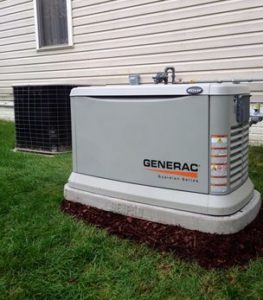
Backup Generator Installation is Important for the Dallas Homeowners so they can prevent risk during black out.
If you live in an area with frequent, prolonged outages, rely on electrically powered medical equipment, or work at home and need to stay connected, a backup generator can protect you from a disruption you may not be able to afford. The installation of a backup generator can deliver whole-house energy during a loss of power, or it can be designed to supply only necessary systems until electrical service is restored. When the power goes out, whether it is due to a massive storm in the area or a localized event that knocks out power to a single street, having a backup generator can save the day.
The biggest factors affecting cost to install your backup generator are size and quality. The choices for buying a backup generator are wide ranging, but when you’re new to this, it can get confusing. The reasons to purchase a backup generator are plenty, all of which will help to improve your business and prevent potential disastrous situations as a result of the loss of your main power supply.
If you think you might want to run your house (or a portion of it) on a generator, take some time to do some planning first. Watch this video on how to install backup generator to your Dallas Home.
How to Install a Backup Generator
How to Install a Standby Generator
This guide is designed to be an overview to help you design and understand an electrical system that allows you to safely change over the source of your power supply to your home from network supplier to a backup or standby emergency generator. The size and type of generator is the subject of a different article. You must use a qualified and registered electrician for this installation.
Choosing a A/B change Over Switch
This switch (also called a manual transfer switch) must be capable of taking the load that your home is supplied with by the power company. This could range from 12 kVa to 29 kVa. Though 12 and 16 kVa are the common domestic supply limits. You will see the size of your supply on your bill or your electrician will advise you. However best practice is to install a 2 pole 100 amp 230/250 volt changeover switch. This will cover all the power supply ranges above. It is unlikely that you will have a generator this size but the switch needs to be able to handle power supplied by your electric company on a daily basis when there is not a power cut.
The switch will have three selectable settings. Normally labelled 1 | 0 | 2 or A | Off | B. If you purchase a switch designed for this purpose then it may be labelled Mains – Off – Generator. Either way they do the same thing. That is they allow you to select either one or the other by switching through a complete disconnection first (the “0” or “Off” setting in the centre). This prevents one electrical system back feeding the other. Having a switch that can be locked or installing the switch in a lockable electrical cabinet might be prudent to prevent accidental activation, though that is probably unlikely.
Installing the Changeover switch
The switch should be installed between your metre and your main trip switch and consumer unit. You cannot install it before the metre. This is not your wire. It belongs to the Electricity Supply Company or network. Only their employees are authorised to work on these wires. Besides were you to install a switch here you would be racking up and paying for units on your metre for electricity supplied from your own generator.
Do not attempt to install it after your mains fuse and consumer unit as you will lose the protection offered by it and its power distribution capabilities. Also some countries like the UK allow ring circuits which has its own issues. So only install it between the metre (and its mains cut of switch) and the main fuse board (consumer unit).
Installing the Connection for the Backup Generator
Typically your electrician with wire the mains through the 1 or the A side of the switch. From the 2 or B side you need to run a mains supply cable (same size that your power main is supplied to you) to a weatherproof electrical cabinet outside your building or home. In this cabinet you will have a weatherproof plug, not a socket. It may be hardwired in the cabinet or be on an extra-long extension so you can plug it directly into your standby generator without the need for an additional extension lead.
It should be noted that installing a whole-house backup generator is not a do-it-yourself project.
Loss of power can cause essential systems to shut down, which is why having a working backup generator can help protect your business. A backup generator can help you make it through a power outage safely and comfortably, prevent damage from occurring to your home by keeping crucial systems up and running, and ensure life goes on normally when your power goes out. The wisest course of action for backup generator installation is to work with a licensed contractor who can help to accurately determine the appropriately-sized system for the home. So when making this decision a homeowner really needs to take into consideration their needs, concerns, safety, and capabilities. Here at Berkeys Plumbing, we are available to discuss any and all of your generator or electric needs. Call us today at (214) 238-8353 for your free quote.
For more related articles and info visit https://www.berkeys.com/category/electrical/
